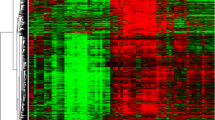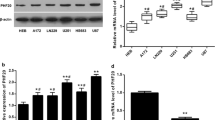Abstract
To identify novel genes associated with apoptosis in glioma cells, we treated T98G glioma cells with okadaic acid (OA). Differential display using 15 random primers was performed on RNA extracted from these cells. Upregulated bands were excised from polyacrylamide gels and cloned. Northern blots were used to confirm RNA expression in T98G cells. 18 RNA fragments corresponding to the untranslated region of genes were identified and sequenced. Three unknown gene fragments were used to screen a fetal brain cDNA library resulting in three complete cDNA sequences. The three sequences corresponded to a human gene homologous to the yeast translation initiation factor Sui-1, a cAMP-regulated phosphoprotein, ARPP-16/19, and a novel gene designated O48. Transcription of Sui-1 increased in response to all stress factors tested, whereas ARPP only responded to OA. 2-kb and 4-kb O48 RNA species were identified. OA and stress factors increased 2-kb expression while K252a (protein kinase inhibitor) increased 4-kb expression. Differential display is effective for identifying genes associated with apoptosis. Novel genes may be identified by further analysis of the gene fragments identified in this study. The function of O48 is unknown.
Similar content being viewed by others

References
Boe R, Gjertsen BT, Vintermyr OK, Houge G, Lanotte M, Doskeland SO. The protein phosphatase inhibitor okadaic acid induces morphological changes typical of apoptosis in mammalian cells. Exp Cell Res 195:237–246;1991.
Brene S, Lindefors N, Ehrlich M, Taubes T, Horiuchi A, Kopp J, Hall H, Sedvall G, Greengard P, Persson H. Expression of mRNAs encoding ARPP-16/19, ARPP-21, and DARPP-32 in human brain tissue. J Neurosci 14:985–998;1994.
Cortes R, Camps M, Gueye B, Probst A, Palacios JM. Dopamine receptors in human brain: Autoradiographic distribution of D1 and D2 sites in Parkinson syndrome of different etiology. Brain Res 483:30–38;1989.
Cui Y, Dinman JD, Kinzy TG, Peltz SW. The Mof2/Sui1 protein is a general monitor of translational accuracy. Mol Cell Biol 18:1506–1516;1998.
Fields C, Adams MD. Expressed sequence tags identify a human isolog of the sui 1 translation initiation factor. Biochem Biophys Res Commun 198:288–291;1994.
Hall H, Farde L, Sedvall G. Human dopamine receptor subtypes- in vitro binding analysis using3H-SCH 23390 and3H-raclopride. J Neural Transm 73:7–21;1988.
Horiuchi A, Williams KR, Kurihara T, Nairn AC, Greengard P. Purification and cDNA cloning of ARPP-16, a cAMP-regulated phosphoprotein enriched in basal ganglia, and of a related phosphoprotein, ARPP-19. J Biol Chem 265:9476–9484;1990.
Hsu DK, Donohue PJ, Alberts GF. Fibroblast growth factor-1 induces phosphofructokinase, fatty acid synthase and Ca(2+)-ATPase mRNA expression in NIH 3T3 cells. Biochem Biophys Res Commun 197:1483–1491;1993.
Katoh F, Fitzgerald DJ, Giroldi L, Fujiki H, Sugimura T, Yamasaki H. Okadaic acid and phorbol esters: Comparative effects of these tumor promoters on cell transformation, intercellular communication and differentiation in vitro. Jpn J Cancer Res 81:590–597;1990.
Kerr JFR. Shrinkage necrosis: A distinct mode of cellular death. J Pathol 105:13–20;1971.
Kiguchi K, Glesne D, Chubb CH, Fujiki H, Huberman E. Differential induction of apoptosis in human breast tumor cells by okadaic acid and related inhibitors of protein phosphatases 1 and 2A. Cell Growth Differ 5:995–1004;1994.
Kondratyev AD, Chung KN, Jung MO. Identification and characterization of a radiation-inducible glycosylated human early-response gene. Cancer Res 56:1498–1502;1996.
Liang P, Pardee AB. Differential display of eukaryotic messenger RNA by means of the polymerase chain reaction. Science 257:967–971;1992.
Mok SC, Wong KK, Chan RK. Molecular cloning of differential expressed genes in human epithelial ovarian cancer. Gynecol Oncol 52:247–252;1994.
Morimoto Y, Ohba T, Kobayashi S, Haneji T. The protein phosphatase inhibitors okadaic acid and calyculin A induce apoptosis in human osteoblastic cells. Exp Cell Res 230:181–186;1997.
Mou L, Miller H, Li J, Wang E, Chalifour L. Improvements to the differential display method for gene analysis. Biochem Biophys Res Commun 199:564–569;1994.
Murakami Y, Oshima Y, Yasumoto T. Identification of okadaic acid as a toxic component of a marine dinoflagellate. Bull Jpn Soc Sci Fish 48:69–72;1982.
Nishio Y, Aiello LP, King GL. Glucose-induced genes in bovine aortic smooth muscle cells identified by mRNA differential display. FASEB J 8:103–106;1994.
Polyak K, Xia Y, Zweier JL, Kinzler KW, Vogelstein B. A model for p53-induced apoptosis. Nature 389:300–305;1997.
Ralph D, McClelland M, Welsh J. RNA finger-printing using arbitrarily primed PCR identifies differentially regulated RNAs in mink lung (Mv1Lu) cells growth arrested by transforming growth factor beta 1. Proc Natl Acad Sci USA 90:10710–10714;1993.
Richfield EK, Young AB, Penney JB. Comparative distribution of dopamine D-1 and D-2 receptors in the cerebral cortex of the rats, cats, and monkeys. J Comp Neurol 286:409–426;1989.
Schonthal A. Okadaic acid. A valuable new tool for the study of signal transduction and cell cycle regulation? New Biol 4:16–21;1992.
Schonthal A, Alberts AS, Frost JA, Feramisco JR. Differential regulation ofjun family gene expression by the tumor promoter okadaic acid. New Biol 3:977–986;1991.
Schonthal A, Tsukitani Y, Feramisco JR. Transcriptional and posttranscriptional regulation of c-fos proto-oncogene expression by the tumor promoter okadaic acid. Oncogene 6:423–430;1991.
Sheikh MS, Garcia M, Zhan Q, Liu Y, Fornace AJ Jr. Cell cycle-independent regulation of p21Waf1/Cip1 and retinoblastoma protein during okadaic acid-induced apoptosis is coupled with induction of Bax protein in human breast carcinoma cells. Cell Growth Differ 7:1599–1607;1996.
Sheikh MS, Fernandez-Salas E, Yu M, Hussain A, Dinman JD, Peltz SW, Huang Y, Fornace AJ Jr. Cloning and characterization of a human genotoxic and endoplasmic reticulum stress-inducible cDNA that encodes translation initiation factor 1 (eIF1(A121/SUI 1). J Biol Chem 4:16487–16493;1999.
Stephen FA, Gish W, Miller W, Myers EW, Lipman DJ. Basic local alignment search tool. J Mol Biol 215:403–410;1990.
Suganuma M, Fujiki H, Suguri H, Yoshizawa S, Hirota M, Nakayasu M, Ojika M, Wakamatsu K, Yamada K. Okadaic acid: An additional non-phorbol-12-tetradecanoate-13-acetatetype promoter. Proc Natl Acad Sci USA 85:1768–1771;1988.
Tachibana K, Scheuer PJ, Tsukitani Y, Kikuchi H, Van Engen D, Clardy J, Gopichand Y, Schmitz FJ. Okadaic acid, a cytotoxic polyether from two marine sponges of the genus Halichodria. J Am Chem Soc 103:2469–2471;1981.
Thevenin C, Kim S-J, Kehrl JH. Inhibition of protein phosphatases by okadaic acid induces AP1 in human T cells. J Biol Chem 266:9363–9366;1991.
Tiao GM, Hudson K, Lieberman MA, Fischer JE, Hasselgren PO. Identification of altered gene expression in skeletal muscle during sepsis using differential display. J Surg Res 64:63–67;1996.
Uchiyama CM, Zhu J, Carroll RS, Leon SP, Black PM. Differential display of messenger ribonucleic acid: A useful technique for analyzing differential gene expression in human brain tumors. Neurosurgery 37:464–470;1995.
Wu MX, Ao Z, Prasad KVS, Wu R, Schlossman SF.IEX-1L, an apoptosis inhibitor involved in NF-κB-mediated cell survival. Science 281:998–1001;1998.
Wyllie A. Glucocorticoid-induced thymocyte apoptosis is associated with endogenous endonuclease activation. Nature 284:555–556;1980.
Wyllie A. Chromatin cleavage in apoptosis: Association with condensed chromatin morphology and dependence on macromolecular synthesis. J Pathol 142:67–77;1984.
Zhang L, Medina D. Gene expression screening for specific genes associated with mouse mammary tumor development. Mol Carcinogen 8:123–126;1993.
Zuo L, Ogle CK, Fischer JE, Nussbaum MS. mRNA differential display of colonic mucosa cells in ulcerative colitis. J Surg Res 69:119–127;1996.
Author information
Authors and Affiliations
Rights and permissions
About this article
Cite this article
Chin, L.S., Singh, S.K., Wang, Q. et al. Identification of okadaic-acid-induced genes by mRNA differential display in glioma cells. J Biomed Sci 7, 152–159 (2000). https://doi.org/10.1007/BF02256622
Received:
Accepted:
Issue Date:
DOI: https://doi.org/10.1007/BF02256622



